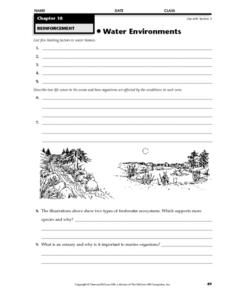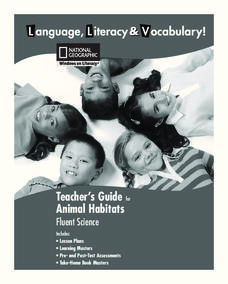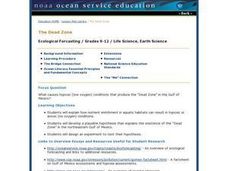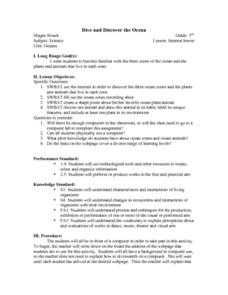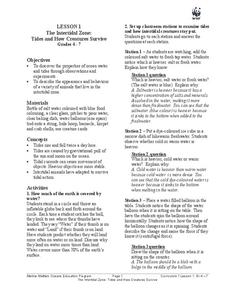Curated OER
Ocean Habitats:
Students investigate the creatures of intertidal zones. They explore the adaptations species make to survive .
Curated OER
Oceanic Habitat Zones
Students explore ocean habitats. In this oceanic environment instructional activity, students research various habitats in the ocean. Then, in a jigsaw format, students teach others in the class about the habitat they researched.
Curated OER
Entering The Twilight Zone
In this lesson sixth grade students get into groups and research a given ocean habitat. The major features of cold-seep communities are the objective but plenty information is given about other habitats which could be assigned to...
Curated OER
Water Environments
In this water environments worksheet, students will brainstorm limiting factors in water biomes, describe the two life zones in the ocean, and compare two types of freshwater ecosystems. This worksheet has 9 short answer questions.
National Geographic
Animal Habitats
Explore animal habitats and reinforce speaking, listening, reading comprehension, and writing skills with a unit that focuses on the Arctic, desert, ocean, prairie, and rainforest. Enthusiastic scientists read informational text to...
Curated OER
The Dead Zone in the Gulf of Mexico
Students explore hypoxic (low oxygen) conditions in the Gulf of Mexico. In this ocean habitat lesson, students hypothesis, design and implement an experiment to explain the existence of the "Dead Zone" in the Gulf of Mexico.
Curated OER
Oceans
Students complete a unit of activities to learn about ocean life as well as improve their math and measurement skills. In this ocean life and math skills lesson, students complete 8 lessons to learn about ocean life and complete...
Scholastic
Study Jams! Aquatic Ecosystems
Mia's friends are fish-sitting while she is away on vacation. Zoe divulges to Sam that different animals need different habitats, and that there are both freshwater and saltwater ecosystems. Examples of the kinds of organisms found in...
NOAA
Deep-Sea Corals
Come take a peak at the corals in the deep. Science scholars discover the hidden world of deep-sea corals in the third installment of a 13-part series. Topics include the differences between shallow water and deep-sea corals, the slow...
NOAA
I Can't Breathe!
The Gulf of Mexico dead zone, an area of low oxygen that kills marine life, costs the United States $82 million every year. Young scientists research anoxic ocean environments then come up with a hypothesis for the cause of the Gulf of...
Curated OER
Mapping The Ocean Floor
Young scholars explore and analyze the bottom structure of underwater habitats. They describe and explain what can't see through the collection and correlation of accurate data. Learners assess that technology is utilized as a tool for...
Curated OER
Ocean Life Zones
In this ocean worksheet, students answer questions about ocean life, the plants and animals of the ocean and their classification, the major life zones of the ocean and questions about an animal of their choice that lives in the ocean.
Curated OER
Coasts and Reefs: Shallow Marine Processes
A more thorough presentation on coastal systems would be difficult to find! Detailed diagrams illuminate the offshore, shoreface, foreshore, and backshore zones of beach. The sources and movement of sediments along the coastline are...
Curated OER
Ocean Tides
In this ocean tides instructional activity, students read 2 pages about ocean tides and answer true or false questions about it. Students complete 10 questions.
Curated OER
Ocean Water and Life
In this ocean water and life worksheet, students match the vocabulary term with the correct definition. Also, students answer questions by deciding if the statements are true or false. Finally, students complete concepts maps while using...
Curated OER
The Magic School Bus Goes to Mussel Beach
Students investigate tides and create a model of an intertidal zone. In this hands-on marine science lesson plan based on a Magic School Bus book, the teacher leads students in a discussion about tides, then helps students model a tide...
Curated OER
Dive and Discover the Ocean
Third graders investigate the three zones of the ocean and the plants and animals that live in each zone. Projects produced are shared with classmates in a share circle where the unique features of the animal and zone selected are...
NOAA
Tides
Low tides, high tides, spring tides, neap tides, diurnal tides, semidiurnal tides, mixed tides ... just how many types of tides are there? The 10th installment of a 23-part NOAA Enrichment in Marine sciences and Oceanography (NEMO)...
Curated OER
In The Zone
Third graders identify ways that ocean animals grow, survive, reproduce, and adapt. They use computer Internet skills to acces and collect information. They create a PowerPoint presentation. They demonstrate writing skills throughthe...
Curated OER
Oceans: Reading Comprehension
Practice reading comprehension by approaching oceanography through 2 pages of informational text. The text give introductory coverage of oceanography in practice, ocean zones, names of the 5 oceans, ocean features, and marine life. Three...
Curated OER
The Intertidal Zone: Tide and How Creatures Survive
Students explore oceanography by completing science worksheets. In this tide pools instructional activity, students discuss the forces of the tide pools, the animals that live within them, and the impact they have on the rest of the...
Curated OER
The Intertidal Zone: Tides and How Creatures Survive
Young scholars study the properties of ocean water and tides and learn about animals that live in intertidal zones. In this intertidal zone instructional activity, students participate in classroom stations to learn about fresh water and...
Curated OER
The Intertidal Zone: Tides and How Creatures Survive
For this intertidal zone worksheet, students study the various marine life creatures and list the characteristic that allows them to stay put in the intertidal zone. Students then draw or cut and paste the marine life and seaweed into...
Curated OER
A Piece of Cake: Ocean Communities
Students explain habitats. For this model based lesson students create a model to help describe a habitat that is typical of deep-water. Students will describe how organisms such as coral and sponges add to their habitat.
Other popular searches
- Ocean Zones Diagram
- Ocean Zones Graph
- Marine Ocean Zones
- Ocean Zones Week 1
- Ocean Zones Worksheets
- Ocean Zones Ppt
- Zones of the Ocean
- Ocean Zones Pot
- Ocean Zones Oil
- Ocean Zones Oil Spill





